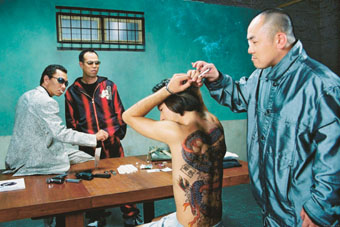 |
Last Life in the Universe |
Thailand has long had a relatively high volume industry concentrating on the domestic market. The international rise of Thai filmmaking is generally dated from 1997 with the overseas release of Pen-ek Ratanaruang’s Fun Bar Karaoke and Nonzee Nimibutr’s Dang Birely and the Young Gangsters. New national cinemas are generally marketed around auteurs as a way of making the unfamiliar familiar, and MIFF’s season centred on Ratanaruang. His Last Life in the Universe has commanded attention on the international festival circuit this year. Shot by Christopher Doyle at his most restrained, the film is a beautifully precise reworking of Ratanaruang’s second feature 6ixtynin9. Asano Tadanobu plays a Japanese librarian continually contemplating suicide, not through any sense of despair, but rather as the ultimate extension of his need for order. His unintentional penchant for causing the deaths of others brings him into contact with Noi, a bar girl who lives in a constant state of domestic chaos. Their relationship is less a case of romantic opposites attracting than the complementary comfort of yin and yang.
The other major Thai filmmaker to emerge internationally is Apitchatpong Weerasethakul, a one-man avant-garde feature film industry. Last year, his Blissfully Yours was either loved or walked out on, and this year’s Tropical Malady similarly divided audiences. Those who appreciated the slow-building intensity of the film were treated to one of the highlights of the festival.
Weerasethakul’s films are fascinating because for all their apparent simplicity and anti-dramatic surface, they are constantly in the process of changing into something else. You can never be quite sure what the film is becoming and they puzzle you in the gentlest of ways. Tropical Malady essentially works in 2 halves. The first deals with a romantic pursuit and flirtatious evasion between 2 men. The second half converts this into an eerie metaphor: the pursuit of a tiger through the jungle. The journey takes you further and further into a stylisation from which there is no turning back. Finally we look into the throbbing darkness to see a tiger gazing back and are asked to contemplate this as an image of desire.
While Thai cinema might be new to us in the West, it has a long history of domestic genres and traditions based on florid melodramas and musicals. Given limited knowledge of these traditions, it’s often difficult to grasp the context the films are addressing. For example, Ratanaruang’s third film, Mon-Rak Transistor is a reworking of luk thung musicals, invoking a brand of Thai country and western music of the 1950s. The hero only wants to be with his true love but events conspire in unlikely ways to frustrate him.
There’s an edge of camp irony which underlies the relation of these new filmmakers to the historical traditions they want to claim as their own. The very ludicrousness of the melodrama can be read as a subversive gesture deriding simplistic moralism and calling into question the supposed certainties of realism and gender. A case in point: The Adventure of Iron Pussy, co-directed by Weerasethakul and the film’s star Michael Showanasai, looks not much more than an extended drag queen romp shot on video. The project has, however, grown out of a video and performance series in which the eponymous heroine functions as a nodal point of trans-gender celebration and satire on the excesses of Thai cinema.
As we inch our way toward the commercial mainstream of Thai filmmaking we come upon The Eye, by Oxide and Danny Pang, Bangkok-based filmmakers who frequently work in Hong Kong. Based on co-production possibilities, The Eye redresses a longstanding situation where south-east Asia has provided only consumers and exotic locations for Hong Kong cinema.
Since Bangkok Dangerous, the Pang Brothers have emerged at the cutting edge of finding new hi-tech ways of blowing holes in people. The Eye is squarely in the post-Sixth Sense/Ringu school of moody horror movie. The game is to keep the first half slow and unsettling, with the audience safe in the knowledge that hell itself will be unleashed in the final reel. This is a genre which has been extremely important in the forging of regional marketing and co-production throughout Asia. Teenagers are increasingly eager to be scared in movie theatres from Seoul to Mumbai as a sign of their cosmopolitan modernity.
With Ong-Bak we’re back to the meat and potatoes of the action film. Forget all this bourgeois Westernised crap that sees a CGI’ed Maggie Cheung moving elegantly through autumn leaves. This film knows the heart of martial arts is still the desire to see a bunch of sweaty guys whopping each other in startling ways. Tony Jaa represents a move back to the pure faith of athletic and senseless violence—and who can complain about that? My favourite moment in the film comes when a bad guy attacks our hero with a chair and is promptly dispatched. The second bad guy tries again with a table. The final villain, having watched and learned, picks up a refrigerator and hits him with that. That’s the kind of narrative logic I can get behind.
I suspect that we’ve seen the peaks of recent Thai cinema in this season, and that from here the standard falls into the abysses of schlock and horror. Even so, Australian audiences need to widen their sense of the production possibilities in Asian film industries. Thailand is yet another nation in the region with the industrial and aesthetic maturity to provide a wide range of answers to the question of what constitutes a national cinema.
Thai Breakers: New Cinema from Thailand, 53rd Melbourne International Film Festival, July 21-Aug 8
RealTime issue #63 Oct-Nov 2004 pg. 21
© Mike Walsh; for permission to reproduce apply to [email protected]








 back
back